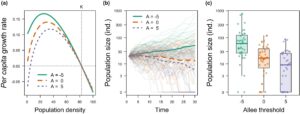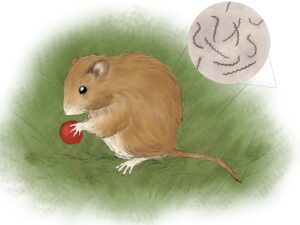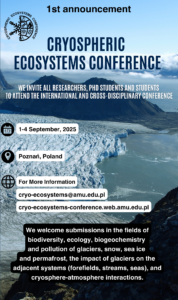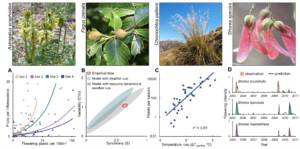About us
In the Institute of Environmental Biology we are pursuing several lines of research concerning ecology of individuals, populations and ecosystems, animal behaviour, bioacoustics, evolutionary biology, phylogenetics, taxonomy and systematics, biogeography, as well as biodiversity, environmental conservation and monitoring. Our study systems include a wide variety of taxa, from bacteria to vertebrates, and we explore many regions in the world, including Arctica, Australia, Africa, North and South America. We offer several BSc and MSc courses, and provide numerous PhD opportunities.
News
- Publication in PNASPublication by Michał Bogdziewicz et al. engages with a recent paper by Meersch and Wolkovich, to discuss how the summer solstice serves as a fixed, range-wide cue that synchronizes temperature sensing for flowering in European beech. Unlike growth processes, where local adaptation to environmental conditions is beneficial, masting relies on synchrony among individuals to enhance…
- Rewiew on mast seedlingsA review by Michal Bogdziewicz and co-authors published in Annual Reviews in Ecology, Evolution, and Systematics explores the phenomenon of mast seeding, where perennial plants produce highly variable and synchronized seed crops. It synthesizes current knowledge on the mechanisms plants use to achieve this variability, from hypersensitivity to weather cues to interactions between pollination, fruit…
- XIII Scientific Session of the Institute of Environmental BiologyXIII Scientific Session of the Institute of Environmental Biology, Faculty of Biology AMU 26 June 2025 – program (link)
- Publication in Ecological IndicatorsAn article co-authored by Zbigniew Celka has been published in the journal Ecological Indicators, focusing on indicator species in three forest types of Poland (Tilio-Carpinetum, Galio-Carpinetum, and Stellario-Carpinetum). The study revealed both new species that currently best characterize the described associations and a significant group of mosses with strong bioindication potential. Link to the paper: https://doi.org/10.1016/j.ecolind.2025.113339
- Virtual speciesA paper presenting a mechanistic simulator of a virtual species has been published in Methods in Ecology and Evolution: https://doi.org/10.1111/2041-210X.14475 The article is part of the PhD thesis of Katarzyna Markowska from the Population Ecology Lab. The research was funded by the National Science Centre (grant no. 2018/29/B/NZ8/00066) and the Poznan Supercomputing and Networking Centre…
- MHC mediates production of antibodies against Borrelia outer surface proteinsIn a study published in Molecular Ecology (http://doi.org/10.1111/mec.17534), Joanna Różańska-Wróbel, Jacek Radwan and their collaborators demonstrate that Major Histocompatibility (MHC) alleles predict production of antibodies against specific variants of OspC, a protein used by Borrelia to manipulate host immunity. The results provide an example of an interaction between immunity and infectivity genes predicted by the…
- Cross-disciplinary Cryospheric Ecosystems ConferenceOrganized by Krzysztof Zawierucha from our institute and colleagues, will be held in Poznań, Poland, on the 1st-4th September 2025. Further information may be found in the conference website https://cryo-ecosystems-conference.web.amu.edu.pl/.
- Logged forests can still have ecological value – if not pushed too farResearchers from around the world, including AMU biologist Jonathan Parrett, have analysed data from 127 studies to reveal ‘thresholds’ for when logged rainforests lose the ability to sustain themselves. The results, published today in Nature, could widen the scope of which forests are considered ‘worth’ conserving, but also show how much logging degrades forests beyond the…
- 30-th Anniversary Scientific Session[fusion_builder_container type=”flex” hundred_percent=”no” equal_height_columns=”no” menu_anchor=”” hide_on_mobile=”small-visibility,medium-visibility,large-visibility” class=”” id=”” background_color=”” background_image=”” background_position=”center center” background_repeat=”no-repeat” fade=”no” background_parallax=”none” parallax_speed=”0.3″ video_mp4=”” video_webm=”” video_ogv=”” video_url=”” video_aspect_ratio=”16:9″ video_loop=”yes” video_mute=”yes” overlay_color=”” video_preview_image=”” border_color=”” border_style=”solid” padding_top=”” padding_bottom=”” padding_left=”” padding_right=””][fusion_builder_row][fusion_builder_column type=”1_1″ layout=”1_1″ background_position=”left top” background_color=”” border_color=”” border_style=”solid” border_position=”all” spacing=”yes” background_image=”” background_repeat=”no-repeat” padding_top=”” padding_right=”” padding_bottom=”” padding_left=”” margin_top=”0px” margin_bottom=”0px” class=”” id=”” animation_type=”” animation_speed=”0.3″ animation_direction=”left” hide_on_mobile=”small-visibility,medium-visibility,large-visibility” center_content=”no”…
- Publication in Trends in Ecology and EvolutionA recent paper of Michał Bogdziewicz and collegues on mast seeding in perennial plants presents a model that integrates proximate factors (environmental variation, weather cues, resource budgets) with ultimate drivers (predator satiation, pollination efficiency). This model illustrates how the relationships between mast seeding and weather influence species’ responses to climate warming, ranging from no change…










